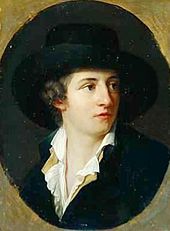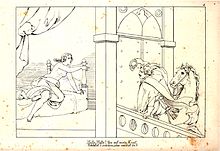Johann Christian Ruhl

Johann Christian Ruhl (born December 15, 1764 in Kassel ; † September 29, 1842 there ) was a sculptor, illustrator and architect in Hessen-Kassel .
Live and act
Ruhl was the son of the cabinet clerk Johannes Ruhl. He studied sculpture with the court sculptor Johann August Nahl . In 1787 he traveled to Paris at the expense of the Hessian elector Wilhelm I to study there for a year under the direction of the sculptor Augustin Pajou . He went on to Italy, where he studied the ancient artists for two and a half years and tried to perfect his skills. In Rome he met Johann Wolfgang von Goethe . He remembered him (or his statue of Achilles) later in his writing about Johann Joachim Winckelmann and his century. After returning to his hometown, he was entrusted with the sculpting work and the decoration with ornaments at Wilhelmshöhe Palace .
At the beginning of the 19th century he worked with Karl Heinrich Schwarzkopf as a modeller for the porcelain factory in Fürstenberg an der Weser.
Jérôme Bonaparte , King of Westphalia, appointed him his court sculptor in 1808 and gave him the supervision of the decoration work on several buildings, which were directed by the court architect Grandjean de Montigny . Among other things, he created the antiqued busts of King Jérômes and his wife Katharina von Württemberg made of bisque porcelain and a bust of the king in marble, which was intended as a gift for Emperor Napoleon. In addition to the portraits of Johann Friedrich Blumenbach , Johann Beckmann , Johann Dominik Fiorillo , Arnold Heeren and Christian Gottlob Heyne , he made one copy for the Georgia Augusta library in Göltingen, and one for the Kassel Palace. For the busts in the library he was awarded the diploma of a Doctor of Philosophy by the University of Göttingen on October 5, 1829. A portrait of the king made by him served as a model for the minting of new coins. When Elector Wilhelm II took office , he received orders for new building projects such as the decoration of the Residenzpalais. He was appointed professor at the Academy of Fine Arts in Kassel . His students included Christian Daniel Rauch , who worked under his direction for around five years, as well as the court sculptor Bernhard Wessel , the sculptor Philipp Siebrecht, who later went to New York, and Gustav Kaupert .
In 1835 he was one of the co-founders of the Kunstverein für Kurhessen .
family
Ruhl married Elisabeth (nee Völkel), a sister of the archaeologist and philologist Johann Ludwig Völkel , with whom he had two sons.
- Ludwig Sigismund Ruhl (1794–1887) was also a painter and was trained by his father.
- Julius Eugen Ruhl (1796–1871), was an architect and Oberhofbaudirektor of the Hessian State Railway.
Works (selection)

- Hessendenkmal in Frankfurt am Main
- several busts and figures made of marble
illustration
- Johann Christian Ruhl: Ossian's poems in outline . 3 issues (1805–1807). St. Petersburg / Leipzig 1805 (On the poem about Ossian ).
- Johann Christian Ruhl: Ideas for decorations for artists and craftsmen from which antiquities collect . Krieger, Marburg 1818, OCLC 246180179 .
- Gottfried August Bürger : The Ballad of Lenore . Luckhardt, Kassel 1827 ( goethezeitportal.de ).
literature
- Georg Kaspar Nagler : New general artist lexicon; or messages from the life and works of the painter, sculptor, architect, engraver, etc . EA Fleischmann, Munich 1835, p. 30–33 ( Textarchiv - Internet Archive ).
- Louis Katzenstein : Ruhl, Johann Christian . In: Allgemeine Deutsche Biographie (ADB). Volume 29, Duncker & Humblot, Leipzig 1889, p. 606 f.
- Ruhl, Johann Christian . In: Hans Vollmer (Hrsg.): General lexicon of fine artists from antiquity to the present . Founded by Ulrich Thieme and Felix Becker . tape 29 : Rosa – Scheffauer . EA Seemann, Leipzig 1935, p. 186 .
- Karin Annette Möller: Porcelain from Fürstenberg. Catalog, Schwerin 2002, ISBN 3-86106-073-6 .
- Wolfgang Riedl: Johann Christian Ruhl. Dissertation Göttingen 1993.
Web links
- Literature by and about Johann Christian Ruhl in the catalog of the German National Library
- Short biography: Johann Christian Ruhl (1764–1842) goethezeitportal.de
- Ruhl, Johann Christian. Hessian biography. (As of July 12, 2020). In: Landesgeschichtliches Informationssystem Hessen (LAGIS).
- Ruhl, Johann Christian in the Frankfurt dictionary of persons
Single receipts
- ^ Ruhl, Johann Christian. Hessian biography (as of February 12, 2020). In: Landesgeschichtliches Informationssystem Hessen (LAGIS). Hessian State Office for Historical Cultural Studies (HLGL), accessed on February 28, 2020 .
- ↑ Nekrolog - J. Chr. Ruhl . In: Morgenblatt for educated readers . No. 20 . JG Cotta'sche Buchhandlung, March 7, 1844, p. 81-83 ( books.google.de ).
- ↑ Möller: Porcelain from Fürstenberg. P. 115 f.
- ^ Georg Kaspar Nagler : New general artist lexicon; or messages from the life and works of the painter, sculptor, architect, engraver, etc . EA Fleischmann, Munich 1835, p. 30–33 ( Textarchiv - Internet Archive ).
- ↑ Ludwig Sigismund Ruhl, Adolf Daniel Crakau: Collection LS Ruhl containing watercolors and copperplate engravings… Collection AD Crakau containing copperplate engravings, etchings and woodcuts… Boerner, Leipzig 1888, foreword ( Textarchiv - Internet Archive ).
| personal data | |
|---|---|
| SURNAME | Ruhl, Johann Christian |
| BRIEF DESCRIPTION | Court sculptor in Hessen-Kassel |
| DATE OF BIRTH | December 15, 1764 |
| PLACE OF BIRTH | kassel |
| DATE OF DEATH | September 29, 1842 |
| Place of death | kassel |
